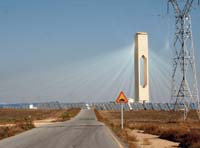Concentrating solar power
The technology to transport this electricity over long distances is already available. It is predicted that CSP will be one of Europe’s cheapest sources of energy in the future. The basic idea of ‘concentrating solar power’ (CSP) is to arrange mirrors so that they concentrate sunlight into a relatively small area and then use the resulting heat to raise steam to drive turbines and generators. Direct sunlight is needed and CSP works best in sunny deserts, where CSP is currently the most cost-effective way of capturing solar energy, although this might change with future developments in photovoltaics (PV).
With CSP it is possible to store solar heat in melted salts (eg. nitrates of sodium or potassium) so that electricity generation may continue at night or on cloudy days. It is also possible to use gas or biofuels as a stopgap source of heat when there is not enough sun.
Significant potential
 The statistics are quite startling. Every year, each km2 of desert receives solar energy equivalent to 1.5 million bbls of oil. Multiplying by the area of deserts worldwide, this is several hundred times the entire current energy consumption of the world. It has been calculated that, if it was covered with CSP plants, an area of desert of about 90 000 km2 (300 × 300 km) - less than 0.5% of the total area of such deserts in the world - would produce as much electricity as is now being used by the whole world.
The statistics are quite startling. Every year, each km2 of desert receives solar energy equivalent to 1.5 million bbls of oil. Multiplying by the area of deserts worldwide, this is several hundred times the entire current energy consumption of the world. It has been calculated that, if it was covered with CSP plants, an area of desert of about 90 000 km2 (300 × 300 km) - less than 0.5% of the total area of such deserts in the world - would produce as much electricity as is now being used by the whole world.
How to make use of this energy
Although not many people live in deserts, CSP could become a major source of clean energy for most of the world.
Energy intensive industries could be relocated so that they can make direct use of thermal or electrical energy from CSP plants in deserts. CSP plants could, for example, be used in the Australian deserts to provide the heat and electricity that is needed to convert bauxite into aluminium, or they could provide heat/electricity for the cement manufacturing process.
Solar energy could be transported over long distances using hydrogen as an energy vector, with the hydrogen being produced by electrolysis or thermal cracking of water. However, this is not an ideal way to create electricity in distant locations, for which purpose transmission of solar electricity via high-voltage transmission lines is preferred. High-voltage AC lines work well over relatively short distances, and high-voltage DC lines work better for long distances. Using this technology, it is possible that electricity could be transmitted from North Africa to the UK with less than 10% loss of power.
The DESERTEC concept
The ideas that have been sketched here are part of the ‘DESERTEC’ concept, a set of proposals for future electricity supplies in Europe, the Middle East and North Africa (EUMENA) that has been developed by the ‘TREC’ international network of scientists and engineers, now reconstituted as the DESERTEC Foundation.
An important part of the DESERTEC concept is the creation of a large-scale HVDC transmission grid, spanning the whole of EUMENA, and designed to work in conjunction with existing HVAC grids. One of the most fascinating aspects of the concept is the various spin-off benefits: for example, waste heat from CSP plants may be used for desalination of seawater.
Costs
The cost of collecting solar thermal energy equivalent to one barrel of oil is about US$ 60 (at the time of writing) and is likely to come down to around US$ 26 in the future. The TRANS-CSP report calculates that CSP is likely to become one of the cheapest sources of electricity in Europe, including the cost of transmission.
For the full report from Gerry Wolff, Co-ordinator of DESERTEC-UK, please see the August 2009 issue of World Cement.
Author: Gerry Wolff, Co-ordinator of DESERTEC-UK.
Read the article online at: https://www.worldcement.com/europe-cis/19102009/concentrating_solar_power/
You might also like
The World Cement Podcast - CleanTech & Venture Capital
Our guest for this episode of the World Cement Podcast is Alfredo Carrato, Venture Capital Advisor for CEMEX Ventures. Listen in to the conversation as World Cement's Senior Editor, David Bizley, and Alfredo discuss the role of venture capital and cleantech in enabling the cement industry's green transition.
Tune in to the World Cement Podcast on your favourite podcast app today.

